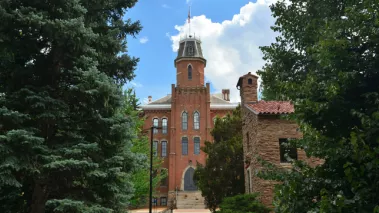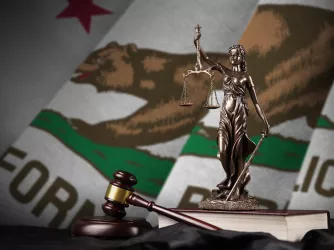Table of Contents
Resolution reached after free expression coalition expresses concerns about art censorship at CU Boulder

On Wednesday, FIRE joined the National Coalition Against Censorship and PEN America in calling on the University of Colorado at Boulder to reverse its decision to relocate student artwork because some students “felt threatened” by its imagery. Fortunately, CU Boulder quickly acknowledged our concerns and is now working with the censored student to make amends.
The exhibit, created as a thesis show by senior Kaelen Williams and curated by recent graduate Kendall Goduto, featured 22 paintings and 15 drawings, some of which depicted self-harm. One piece depicted a noose, which Williams said was meant “to reframe the idea of suicidal ideation, which I think is a much more prevalent sort of thing than we like to acknowledge.” The noose painting was also used as a promotional image for the exhibit. Williams further said it was intended “not to, obviously, support suicide but just to present it in a different light as possibly a desire to return to a state of unity with the universe.”
Last Thursday, on the day before the exhibit’s opening, Williams and Goduto were stopped while installing the exhibit in their reserved space in the Visual Arts Complex lobby and informed that their promotional posters had been removed after student complaints. Then on Friday morning, chair of the Art and Art History department Kirk Ambrose contacted them about moving the exhibit: “The faculty of Art & Art History met today and determined that the venue for your current BFA Exhibition is inappropriate. After your opening this evening, you have [the] option of moving your work to (Visual Arts Complex) 1B32 by 8am Monday, December 4 …” The exhibit could still be seen, but only in the basement of the Visual Arts Complex.
In protest, Williams launched a petition arguing that “the department is setting a bad precedent regarding free speech, and combatting this decision will benefit every student and faculty member on campus, as well as the University itself,” and that “campuses in general and art departments in particular are meant to be places where we can explore challenging ideas.” As NCAC explained on Monday, it’s clear that Williams’ work was relocated to assuage student complaints.
The university defended its decision in a statement from spokesperson Deborah Mendez Wilson, who wrote, in part:
The student was asked to relocate his artwork because students and others felt threatened by some of the images contained in the exhibition, including a noose, hooded figures and satanic images. Nevertheless, we wanted to give the artist the opportunity to continue to display his work, and still allow visitors the choice as to whether they wanted to view his creations.
Wednesday’s letter from FIRE, NCAC, and PEN America warned CU Boulder about the obvious danger of allowing student complaints to determine what artwork members of the community should see. We wrote that “[w]hile it is inevitable that some artworks will disturb some viewers, obstructing open dialogue around difficult subjects fosters silence rather than understanding.”
CU Boulder’s decision was especially concerning in light of the University of Colorado Board of Regents’ adoption of robust free speech policies in September, including its “Governing Principles” on free expression. Our letter reminded CU Boulder that its treatment of Williams’ exhibit flies in the face of the governing principles’ directive that “[t]he proper response to ideas that members of the university community find offensive or unwarranted is to challenge those ideas through the exercise of reason and debate, rather than attempt to interfere with or suppress them.”
As FIRE, NCAC, and PEN America made clear to CU Boulder, there are ways for universities to respond to art controversies without obscuring the art in question — namely by opening up more conversations rather than, quite literally, relegating them to the basement. Fortunately, CU Boulder is now working on fostering those conversations. The university announced late Wednesday evening that it had reached a resolution with Williams:
The CU Boulder Art and Art History Department has come to a mutually satisfactory resolution with an art student whose work was relocated to another venue in the campus’s Visual Arts Complex.
The student has agreed to allow his art to remain in its current location through Dec. 9, and will join forces with a faculty member who is a public art expert to create a mural that will be displayed in the lobby of the arts complex next spring. In addition, faculty and students are planning a symposium to further the discussion about art, free expression and academic freedom.
These are positive outcomes for the student, the department and the university. Even so, the university recognizes that it has more work ahead when it comes to reinforcing its values on the importance of free expression, free speech and academic freedom through art and other endeavors.
Moving forward, we will build on this example, using it as a learning experience for our academic community, and we invite all students, faculty and staff to continue the discussion in galleries, classrooms, lecture halls and among friends and colleagues.
Williams reported to student newspaper The Daily Camera that having the opportunity to create a mural in the space where his work was originally censored is a “really good solution.”
FIRE is pleased that CU Boulder has chosen to work with Williams and host a symposium to address the issues at play here. We are also pleased the CU Boulder’s statement recognized that its response to Williams’ exhibit failed to meet the free expression standards promised by the university, a major concern raised in our letter.
FIRE has documented a number of cases over the past two decades where universities censor art by means of relocation or obfuscation — in the hopes that hiding divisive artwork will quell the controversy it started — in our report on art censorship released this summer, “One Man’s Vulgarity.” Unlike many universities discussed in the report, CU Boulder is seeking to learn from its art controversy, rather than pretend it never happened.
Recent Articles
FIRE’s award-winning Newsdesk covers the free speech news you need to stay informed.

O holy fight: New Hampshire Satanic Temple statue threatened by more than vandals

California and other states are rushing to regulate AI. This is what they’re missing

One day after FIRE lawsuit, Congress passes changes to filming permits in national parks
